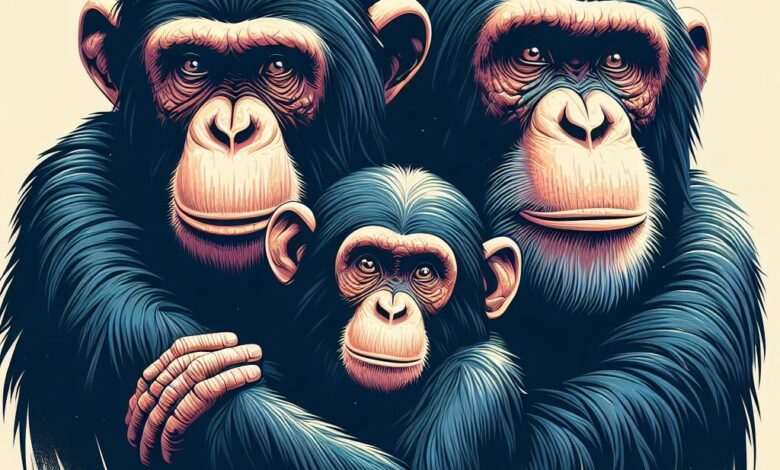What Can We Learn From the Social Structures of Great Apes?

Great apes—gorillas, chimpanzees, bonobos, and orangutans—are our closest living relatives, sharing a remarkable degree of genetic similarity with humans. Their complex social structures offer fascinating insights into the nature of social behavior, cooperation, and communication. By studying these social dynamics, we can gain a deeper understanding of our own social interactions and the evolution of human societies.
1. Complex Social Hierarchies
Great apes exhibit intricate social hierarchies that reflect a spectrum of relationships and roles within their groups. For instance:
- Chimpanzees: Chimpanzee societies are known for their fluid hierarchies, which are often influenced by individual alliances and conflicts. Alpha males, who lead the group, maintain their status through a combination of aggression and diplomacy. These dynamics showcase the importance of social alliances and power struggles, similar to human political systems.
- Gorillas: Gorilla groups are typically led by a dominant silverback male who is the primary protector and leader of the troop. The silverback’s authority is largely respected due to his strength and experience. This leadership model highlights the role of experienced leaders in maintaining group cohesion and stability.
2. Communication and Social Bonding
Great apes use a variety of communication methods to express emotions, coordinate activities, and resolve conflicts:
- Chimpanzees and Bonobos: Both species use vocalizations, facial expressions, and body language to communicate. For example, chimpanzees use pant-hooting calls to signal their presence or excitement, while bonobos engage in sexual behaviors as a means of social bonding and conflict resolution. These forms of communication reveal the nuanced ways in which great apes navigate social relationships and maintain group harmony.
- Orangutans: Orangutans are known for their more solitary nature, but they still engage in complex vocal communication. Their calls can convey different messages, such as signaling distress or attracting mates. This demonstrates how communication evolves based on social structure and environmental factors.
3. Cooperative Behavior and Altruism
Great apes display remarkable levels of cooperation and altruism within their social groups:
- Chimpanzees: Chimpanzees often collaborate in activities such as hunting and grooming. They have been observed sharing food and supporting each other in times of distress, which underscores the importance of mutual aid and cooperation for survival. These behaviors suggest that altruism and cooperation have deep evolutionary roots and are essential for building strong social bonds.
- Bonobos: Known for their peaceful and cooperative nature, bonobos frequently use sexual behaviors to resolve conflicts and strengthen social ties. Their approach to conflict resolution and social bonding provides a unique perspective on how cooperative behaviors can foster group cohesion and reduce aggression.
4. Parenting and Caregiving
The ways in which great apes care for their young offer valuable insights into parenting and family dynamics:
- Gorillas: Gorilla mothers exhibit strong maternal instincts, nurturing their infants with close physical contact and protection. The bond between a mother and her infant is crucial for the young gorilla’s development and survival. This caregiving behavior highlights the importance of parental investment in ensuring the well-being of offspring.
- Chimpanzees: Chimpanzee mothers also provide extensive care for their young, teaching them essential survival skills and social behaviors. Older siblings and other group members may assist in caregiving, illustrating the role of extended family and social networks in child-rearing.
5. Social Learning and Cultural Transmission
Great apes are capable of social learning, where they acquire skills and knowledge from observing others:
- Orangutans: In the wild, orangutans have been observed using tools, such as sticks to extract insects from crevices. These behaviors are passed down from one generation to the next, demonstrating the role of cultural transmission in the development of survival skills.
- Chimpanzees: Chimpanzees exhibit varying tool use and foraging techniques depending on their geographic location, indicating that cultural practices can differ between groups. This variation highlights how social learning and cultural evolution play a togel resmi role in shaping behaviors and adaptations.
6. Implications for Human Social Behavior
Understanding the social structures of great apes not only enriches our knowledge of their lives but also provides valuable insights into human behavior:
- Social Hierarchies: Studying great ape hierarchies can offer parallels to human social structures, including leadership dynamics, power relationships, and conflict resolution strategies.
- Communication: By examining how great apes communicate, we gain insights into the evolution of human language and non-verbal communication, shedding light on the development of complex social interactions.
- Cooperation and Altruism: Observing altruistic behaviors in great apes helps us understand the evolutionary roots of cooperation and empathy, which are fundamental aspects of human social relationships.
In conclusion, the social structures of great apes provide a window into the complexities of social behavior, communication, and cooperation. By studying these fascinating creatures, we not only gain a deeper appreciation for their lives but also uncover important parallels to human social dynamics. This knowledge helps bridge the gap between our species and our closest relatives, fostering a greater understanding of both great apes and ourselves.
